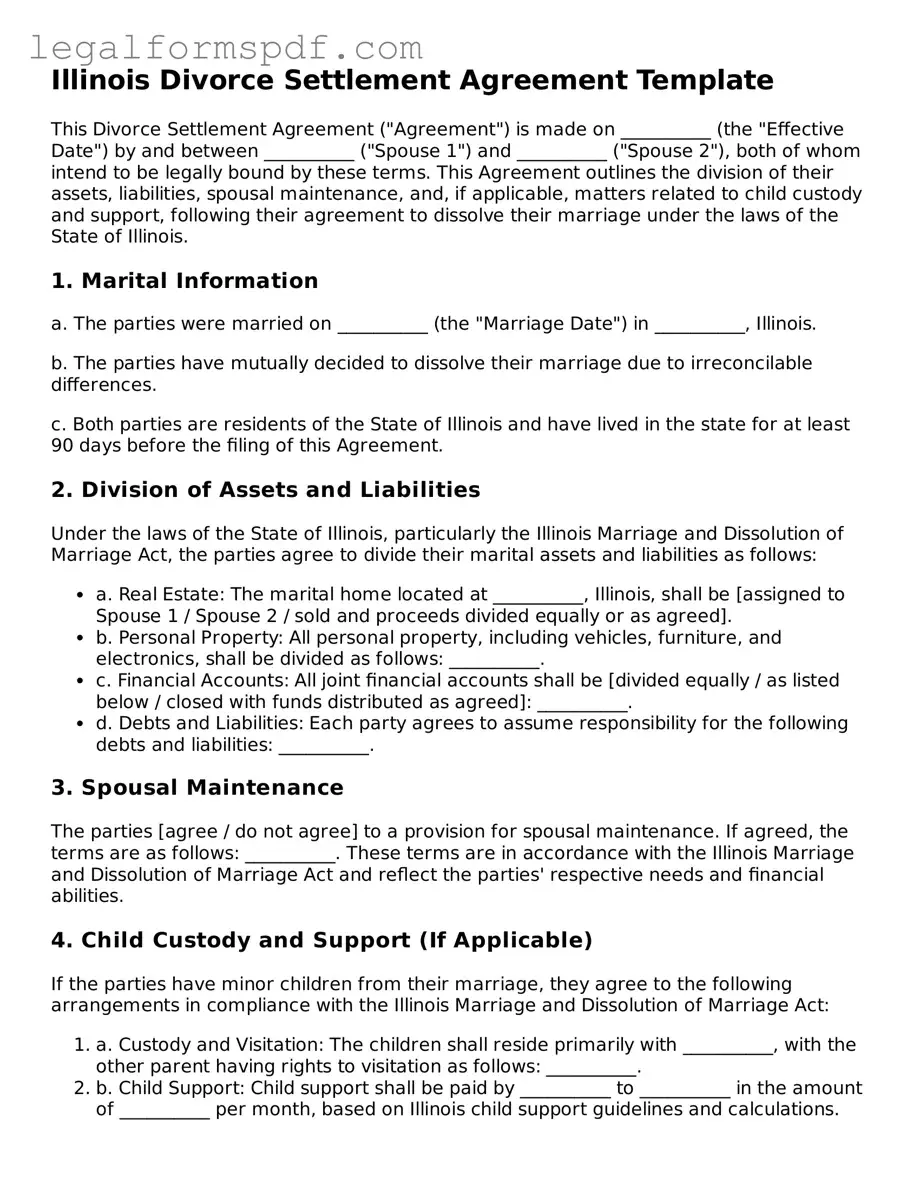What is an Illinois Divorce Settlement Agreement?
An Illinois Divorce Settlement Agreement is a legal document that outlines how divorcing spouses have agreed to divide their assets, property, debts, and other responsibilities. This agreement also covers arrangements related to child custody, support, and visitation, if applicable. Essentially, it's a detailed blueprint of how each aspect of the marriage will be settled upon the dissolution of the marriage.
Do I need a lawyer to create an Illinois Divorce Settlement Agreement?
While it is not legally required to have a lawyer to create a Divorce Settlement Agreement in Illinois, it is highly recommended. Legal assistance ensures that the agreement is fair, comprehensive, and complies with Illinois law. Lawyers can provide invaluable advice and insight, especially in complex situations involving significant assets or custody issues.
Can I modify my Divorce Settlement Agreement after it is finalized?
Yes, modifications can be made to a Divorce Settlement Agreement post-finalization, but only under certain conditions. Both parties must agree to the changes, or one party must prove a substantial change in circumstances to the court's satisfaction. Any modification requires court approval to be legally binding.
What should be included in my Illinois Divorce Settlement Agreement?
Your Illinois Divorce Settlement Agreement should include detailed arrangements about asset division, debt responsibility, spousal support, child support, custody, and visitation schedules. It should also encompass insurance policies, retirement accounts, and any other relevant matters. Detailed listings and a clear outline of responsibilities ensure no aspect is overlooked.
How is child support determined in an Illinois Divorce Settlement Agreement?
In Illinois, child support is determined according to the "income shares" model, which considers the combined income of both parents and the number of children being supported. The state provides guidelines for calculating support amounts, aiming to maintain the child's standard of living as if the parents were not divorced. This calculation can be included in the Divorce Settlement Agreement.
How can I ensure my Illinois Divorce Settlement Agreement is enforceable?
To ensure your agreement is enforceable, it must be written clearly, signed by both parties, and approved by a judge. It's crucial that the agreement complies with Illinois law and that all disclosures about assets and liabilities are completely transparent. A court will review the agreement to ensure it is fair, reasonable, and in the best interests of any children involved before granting approval.
What happens if we cannot agree on a settlement?
If both parties cannot come to an agreement, the divorce may proceed to trial, where a judge will make decisions regarding the division of assets, custody, and other aspects. This process can be lengthy, costly, and emotionally taxing. Mediation is often recommended as a step to finding mutual ground before considering litigation.
Is spousal support automatically included in an Illinois Divorce Settlement Agreement?
Spousal support, also known as alimony, is not automatically included in a Divorce Settlement Agreement in Illinois. It must be agreed upon by the parties or ordered by the court if one party requests it. The determination is based on several factors, including the length of the marriage, each party's financial needs, and earning capacities.
